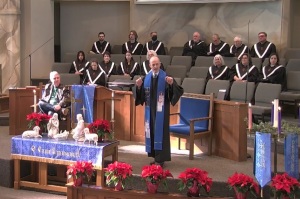Modern Santa Has Little in Common With 'Original' One, Scholar Says
No Christmas passes by without depictions of Santa Claus, and yet we know little about St. Nicholas, the real man behind the red-suited, white-bearded legend. A U.S. scholar, who discovered the truth about him, offers insights on what the "original" Santa was known for.
While the vast majority of saint stories that circulated in the early church involved extraordinary miracles and healings or dramatic martyrdoms and confessions of Christ, the story of Nicholas was about a regular family facing a familiar crisis to which ordinary people could relate, writes Adam C. English, author of The Saint Who Would Be Santa Claus: The True Life and Trials of St. Nicholas of Myra, in an article on CNN's Belief Blog.
A rigorous research by English, associate professor of religion at Campbell University in Buies Creek, N.C., took him to a tomb at the Basilica di San Nicola in the town of Bari on Italy's Adriatic coast, where lies the "real" Santa Claus.
The tomb dates to the 11th century, but Nicholas lived around the fourth century, and was bishop of a church in Myra on the southern coast of modern-day Turkey. At the center of his recognition as a unique saint is the tale of three poor daughters.
Nicholas learned that a citizen of Patara – in Lycia, modern-day Turkey – who had once been wealthy, had become extremely poor, English writes, narrating the incident according to tradition. Having no money for dowries to marry off his three beautiful daughters, the poor man feared they would each be forced into prostitution to support themselves.
To help the man, Nicholas bagged a sum of gold and tossed it through the man's window in the dead of night to help the man pay for the first daughter's marriage. Nicholas made another visit to the man's house sometime later so that the second daughter might marry, but he found the windows closed. So he dropped the bag of gold down the chimney, and it landed into one of the girl's stockings.
Nicholas returned to deliver anonymously the third bag of gold for the last daughter, and the curious father leapt to his feet and raced outside, where he caught the giver of the gift. But Nicholas made him swear never to tell anyone what he'd done. He did not want praise or recognition for his generosity.
This act of anonymous kindness with bold initiative made Nicholas "the most popular nonbiblical saint in the pre-modern church," says English. More churches were dedicated to him than to any other person except Mary, the mother of Jesus, he notes.
In the 1080s, sailors from Bari plundered the tomb of St. Nicholas. They found his bones floating in a sweet-smelling liquid. Known as the myrrh or manna of St. Nicholas, the liquid was highly valued for its purported miraculous and therapeutic qualities, English says. So the bones were taken back to Italy and a basilica was erected in Bari to house them. To this day, Nicholas' tomb continues to excrete a small amount of watery liquid, he adds.
The significance of the "original" Santa has been diluted, English concludes. "Instead of fixating on the commercialization and greed that plague the modern Santa Claus, I chose to see in it the lasting power of a simple act of kindness."




























